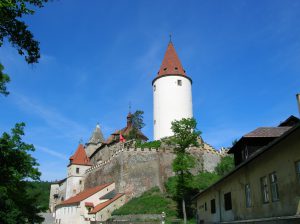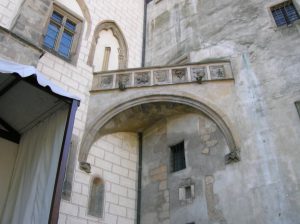Křivoklát Castle
By Tracy A. Burns
A mere glance at Křivoklát Castle will transport you back to the Middle Ages. A spectacular Gothic chapel, a vast and impressive library, a portrait gallery, and an exhibition of medieval art are just a few of the highlights of the 100-minute tour.
 History
History
Křivoklát’s history is intriguing, though riddled with fires. First mentioned at the beginning of the 12th century, the castle was completed in early Gothic style when the Přemyslid dynasty ruled the Czech lands in the 13th and beginning of the 14th centuries. The upper courtyard and tower that can be climbed today hail as far back as the 13th century. It was reconstructed and expanded in the 14th and 15th centuries when Czech king and later Roman king Václav IV reigned. Under his Guyance the castle played a significant role in the country. Then dark days came as Křivoklát was conquered by both the Hussites and the Catholics during the Hussite wars in the 1400s. In the 15th and 16th centuries, Vladislav Jagollen, also known as Czech king Vladislav II, reconstructed it again, this time in the late Gothic style. Once more, life at Křivoklát flourished. However, the castle was not well cared for during the 16th and 17th centuries when it only functioned as a prison. Later, in 1733, Křivoklát came into the hands of the Fürstenbergs. A fire devastated the castle in 1826, but the Fürstenberg clan restored it in the 19th and 20th centuries. Then, in 1929, the Fürstenberg family sold Křivoklát to the Czech state.
Historical figures
Historical figures spent time in the prison that is visited on the tour. The future emperor Charles IV was imprisoned here as a child for three years. Because he had fought against the Habsburgs in the 1548 uprising, Bishop of Bohemian Brethren Jan Augusta had to call the prison home for 16 years, living in a room with no light. One step into the space where Jan Augusta was imprisoned and the visitor senses the harsh conditions in which Augusta endured so many agonizing years. Those are not the only historical figures who inhabited the prison, though. In 1591 alchemist Edward Kelly was incarcerated at Křivoklát because he killed someone in a duel.
 Gothic architecture
Gothic architecture
The gem of the tour is one of the best-preserved Gothic chapels in Europe, with an altar hailing from 1490. Statues of the 12 apostles hover high on the walls. Saint Peter grips a golden key and dons gold drapery, while Saint Andrew wields a sword. Jesus, flanked by two angels, is on top of the altar with two side wings. It is almost possible to see Jesus’ scant clothing blowing in the wind. The angels are adorned with golden wings. The altar celebrates the crowning of the Virgin Mary, who wears gold drapery, and the four panels show the Virgin Mary and Christ in various scenes. For example, one picture shows the birth of Christ. Notice the golden halo above Mary’s head in the four panels.
Library
The library, put together in the 18th century, is daunting with its 53,000 volumes. Some of the books written in German, Italian, French, Latin, and other languages have golden spines. Very few Czech books make up the collection. Hebrew Didactics, the biggest book, weighs 11 kilos, dates from the 17th century, and has 2,500 pages. Take a good look at the wooden chairs: they have decorative backs with birds and swirly shapes, and peacocks on top. Above a doorway, there are paintings of the castle’s appearance before the very destructive fire of 1826.
Portrait Gallery
The portrait gallery is well worth a visit and features ceramics, such as jugs, vases, and plates as well as paintings. The oldest portrait is also the smallest, hailing from 1577 and depicting Albrecht of Fürstenberg donning a high, stiff, white-collar and gazing inquisitively at the viewer.
Other rooms
Another space that amazes me is decorated with altarpieces, statues, and paintings from the Gothic period. Notice the astounding detail of the wooden figures’ hair curls in “The Death of the Virgin Mary.” An enthralling triptych of Archangel Michael from 1500 provides great detail in his wings. One room that will catch your attention is decorated with Baroque and Rococo sleighs. Perhaps the most beautiful sleigh has townscapes of Amsterdam painted on its sides, and knights’ armor on the wall behind it. In the Big Knights’ Hall, 28 meters long and eight meters wide, there are superb statues and floral decorations on the pillars. The oratory offers an excellent view of the chapel and boasts a brown pulpit with gold décor. Torture instruments are displayed on the ground floor. Men and women were kept in separate cages, and the women were usually punished for infidelity. Notice the small window in the ceiling that gives forth only a sliver of light. A chest weighing 100 kilos is displayed elsewhere on the tour.
Ramparts and tower
Take advantage of the spectacular views from the ramparts and the 42-meter high tower. It takes 72 steps on a narrow, winding staircase to get to the top of the 13th-century structure. While waiting for a tour, it is possible to visit various shops in the main courtyard. One small store sells coins embossed with pictures of the castle, while another specializes in items made from wood. Ceramics are also for sale. You can even try your hand at archery. There is also a snack bar.
Křivoklát is most accessible by car, but direct buses from Prague go there on weekends. By train change in Beroun or Rakovník.
If you are looking for a Gothic experience, do not hesitate to visit Křivoklát.



